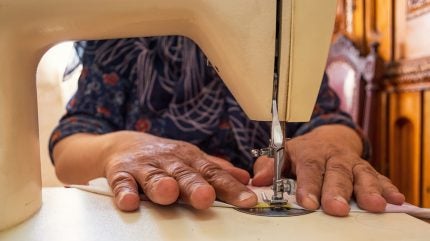Egypt government investments boost global fashion sourcing status

EGYPT GOVERNMENT INVESTMENTS BOOST GLOBAL FASHION SOURCING STATUS
Government
investments to revitalise Egypt’s upstream textile industry are making the
country increasingly attractive as a sourcing destination for textiles and
fashion.
Industry experts explain low costs, an integrated value-chain, proximity to major consumer markets and trade agreements are all boosting Egypt’s appeal to fashion sourcing executives.
Following decades of neglect and under
performance at state-run textile factories, in 2019, Cairo launched initiatives
at 65 facilities to modernise production and provide energy, a ‘National
Project for the Development of the Spinning, Weaving, and Textile Industries’.
Its aim was to increase yarn production
five-fold to 130,000 tonnes-a-year, and textile production by eight times to
198m metres-a-year. This includes building the ‘Spinning 1’ factory, by the
state-owned Misr Spinning and Weaving Company, part of the Cotton, Spinning,
Weaving, and Ready-Made Garments Holding Company, which was completed at the
end of 2024 and slated to start this year
The government’s Ministry of Public Business Sector has touted the plant as the
largest worldwide in terms of the number of spindles under one roof. It is able
to produce 15 tonnes of Egyptian cotton yarn daily with an additional
neighbouring plant also run by Misr Spinning and Weaving recycling yarn
for weaving now under construction.
Nearly half of all investments made under
this government programme have been in the Misr Spinning and Weaving Company.
Other developments are underway in cities surrounding Cairo, including Kafr
El-Dawar, Damietta, Mansoura, Minya and Helwan.
Being completed in phases and slated for
full completion by 2026, output from these new and expanded factories has not
yet entered the market. However, there is optimism that heightened domestic
production will reduce import dependency on China and India yarn and textiles
and will improve the integrated supply chain.
“Putting a factory together doesn’t happen
overnight, particularly as some of these investments are humongous, but in the
medium term the hope is the Mahalla al-Kubra projects will be integrated into
the domestic supply chain and the regional ones. To make good on the
investments, they will need to produce what the market needs,” said Mohamed
Kassem, chairman and CEO of the World Trading Company Egypt, and chairman of
‘Expo Link’, the Egyptian Exporters Association.
Samer Riad, general director of Riad Group,
a textile and garment manufacturer, in Cairo, said restrictions in upstream
production for wovens, including spinning, has restricted overall Egyptian
textile and clothing production growth: “The upstream side has always been an
issue. Once output has increased this may drive down prices, as currently it’s
more expensive than sourcing cotton and yarn from India. Sourcing from
government factories will be easier than from abroad. A good focus would be
more on the mass market (staple) counts that work for t-shirts and
sweatshirts,” he said.
T-shirts and polo shirts accounted for a
majority of knitted exports from Egypt last year, at $484m out of a total of
$921m of all knitted exports, with overall growth of 13% in 2024 on the
previous year.
Woven apparel exports accounted for $1.92bn,
up 21% on 2023. Total apparel exports increased 18% in 2024 on the previous
year, to $2.8bn, with the US accounting for the lion’s share at $1.19bn,
followed by Europe at $689m, according to the Apparel Export Council of Egypt.
Textile exports reached $1.132bn in 2024, up
2% on 2023, according to Egypt’s Textile Export Council, which has set a target
of 15% growth this year, or $180m, to reach $1.312bn.
Navdeep Sodhi, a partner at
Switzerland-based Gherzi Textil Organisation, said strengthening and
modernising capacity in Egyptian spinning “will pay off in the long run”. Low
power costs and competitive labour costs are further advantages to improve the vertically
integrated supply chain. “There has been an infusion of state-of-the-art
spinning machines, which helps to improve yarn quality and backward
integration. Egypt has also strengthened its processing capabilities,
particularly for knits, and has the flexibility to process synthetic materials,
on which tariffs are much higher, especially in the USA,” he said.
On top of state investment, private
investment from Chinese and Turkish firms in Egyptian textiles and garment
manufacturing is on the rise as companies look to diversify sourcing and to
take advantage of Egypt’s trade agreements with Europe, Africa and the US: “We
see that once these large Chinese investments are also installed, this will
further help in value addition. The government has been quite supportive of the
enabling environment, with a lot of public-private investment in special
economic zones and industrial parks, which will give further impetus to attract
foreign investment,” said Sodhi.
